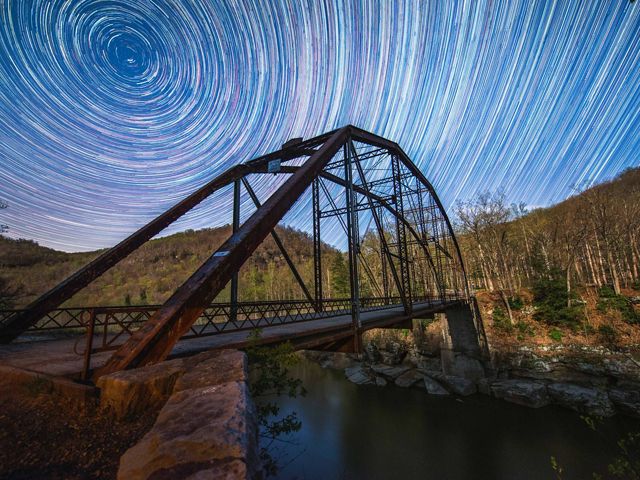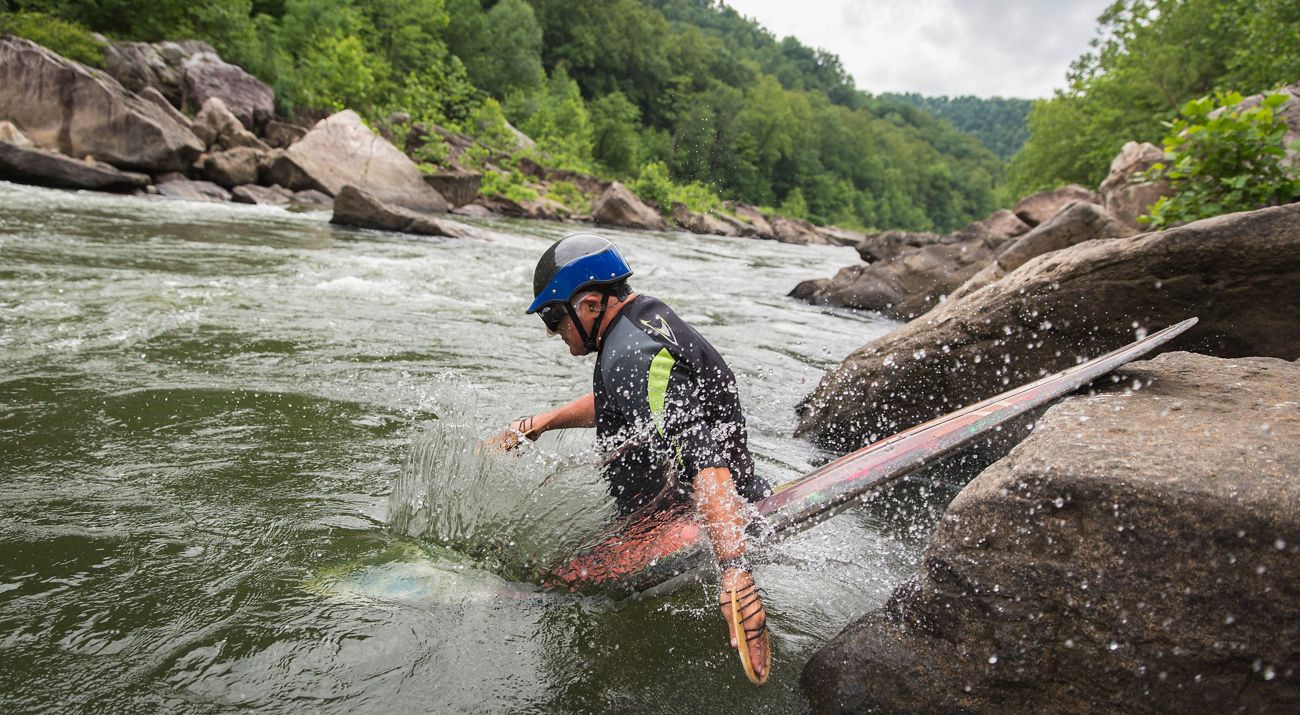I shoot over the drop, flying out of my kayak. Coughing and choking, I pop up in a wave train—essentially a wet roller coaster—that whumpity-bumps me downstream until I’m finally spit into a calmer pool.
In a patch of slow water before that rapid, Jim Snyder—a paddling legend who has been riding West Virginia’s Cheat River since 1970—described the safe route for me to take. I listened, but failed to execute his instructions and got sideways. That’s what led to this impromptu swim. My companions all stayed upright and help reunite me with my gear. The rest of my group, locals and transplants alike, know and love this rugged stretch of river. Each works in outdoor recreation, conservation or a mix of the two, and each helped restore the river from a polluted mess. I’m in good hands.
I flop onto the deck of my kayak like an exhausted walrus. Even in the low water of August, this section of the Cheat River has 27 significant rapids—that’s 27 separate mazes of stone and speeding water. I just wiped out in number 23, and after eight hours of paddling, hiking, surveying the canyon and tumbling through the rinse cycle, my entire body has the rigidity of an overcooked noodle.
For years, I’ve wanted to ride this stretch of river, and it hasn’t disappointed. Along the entire route, dense forest climbs straight up the canyon walls. We’re paddling freeflowing whitewater, and we haven’t seen anyone else all day.
Snyder has run the canyon more than 1,000 times. Though generous with his advice, he doesn’t coddle me. He started the day with a warning, “The Cheat protects itself by being hard-ass. It’s dangerous, difficult and bony.” And throughout the trip he has underscored the importance of avoiding specific obstacles with vivid descriptions of broken boats, broken bones and drownings of the previous paddlers who misjudged the currents and rapids. I’m happy to have escaped my dunking with scraped shins.
The Cheat River Canyon was an early go-to spot for river rats. As whitewater paddling developed in the 1970s, '80s and ’90s, the canyon saw as many as 20,000 people in a year. Now Snyder estimates it’s just a few thousand on the whole river. In 1994 an improperly sealed coal mine blew out. Millions of gallons of polluted water spilled from a tributary into the Cheat. Fish died for 16 miles downstream. In 1995 there was another blowout. Feeder creeks turned a toxic orange. American Rivers listed the Cheat among the 10 most-endangered rivers in the nation. When paddling meant nosebleeds and stinging eyes from the water, people stopped coming.
And as it suffered the declines in water quality, the Cheat became overshadowed by other rivers that run deeper and faster (and above all, more predictably) on the timed water releases of their dams. Now, thanks to a group of conservation partner organizations and many impassioned locals, this canyon and its river are protected. In a state whose economy has long depended on resource extraction, more than a few West Virginians hope for a future in recreation—the future the Cheat used to have.
Each member of our group has history on this river, which crosses north-central West Virginia and flows into southwestern Pennsylvania. Snyder builds custom wooden paddles in his workshop, where Chris Jenkins—a native whose family goes back nine generations here—also works. Mike Powell, the Conservancy’s stewardship manager for the state, started rafting this canyon while working as a whitewater guide during college. Our trip has the practical purpose of assessing some logistics involved with owning the canyon.
West Virginia has only 1.8 million residents, but it’s on the doorstep of some of the most densely populated areas in the country. One-third of the U.S. population lives within a day’s drive of the Cheat, making recreation a powerful economic tool and an effective ally for conservationists. Part of the Central Appalachian ecoregion, West Virginia has among the highest concentrations of temperate hardwood forest biodiversity anywhere in the world. Like much of the state, Preston County, home of Cheat Canyon, was logged and mined. And local environmental groups have been working to fix the existing damage.
The group’s final paddler is Lauren Greco, who coordinated remediation monitoring for the Friends of the Cheat. Formed in 1995, the organization has expanded grass-roots advocacy into building and maintaining systems that treat legacy acid mine drainage, which had turned entire streams to the acidic pH of vinegar. Pyrite—common in the high-sulfur coal of the area—produces acidic mine drainage, which further dissolves heavy metals that damage ecosystems in and near waterways. Some remediation systems use passive leaching pools or wetlands. Others are more Rube Goldbergian, employing water wheels to trigger dosages of lime, which lowers pH levels.
Remediation is transformative, but only as long as the system is kept running. “It’s not a one-and-done thing. It’s perpetual maintenance,” says Amanda Pitzer, executive director of the Friends of the Cheat. This part of the state is “not getting fracked to death. We’re not getting the tops of our mountains cut off. But we have our legacy issues.”
Today, after two decades of hard work, the river has revived. The recreational fishery has rebounded, and 26 miles of the Cheat River have come off the state’s list of impaired waterways. “I never thought it would happen in my lifetime, let alone in my tenure at Friends of the Cheat,” says Pitzer. “For West Virginia, this is such a huge victory.”
She sees the tight-knit communities in the hardscrabble Appalachian towns along the banks as primed for a renaissance. There’s whitewater, rail-to-trail biking and tons of hiking. A new bed-and-breakfast has opened. And Pitzer hopes the long-closed pub where whitewater paddlers used to gather to tell stories after a day on the water will finally reopen.
Friends of the Cheat’s highest-profile work is putting on Cheat Fest, an annual celebration of the river that draws locals as well as whitewater paddlers from around the region and even the world for music, art and a race down Cheat Canyon. The festival not only brings much-needed business to the area, it also goes a long way toward funding Friends of the Cheat’s day-to-day operations.
Now, residents have reason to celebrate. The canyon has been permanently protected as the result of a $7 million deal secured by The Nature Conservancy, The Conservation Fund, the U.S. Fish and Wildlife Service, and the West Virginia Division of Natural Resources to purchase more than 3,800 acres encompassing almost 8 miles of the canyon spanning the ridgelines.
The day before the paddling trip I walked along the wall of Cheat Canyon on an overgrown railroad bed with Keith Fisher, the Conservancy’s director of conservation for West Virginia. Gauzy summer fog lingered in the hollows of the rumpled landscape. “Whenever you are protecting a river ecosystem, protecting the watershed is as important as what happens in the water,” he said.
Creeks and waterfalls thread to the canyon floor through this forest of red oak, shagbark hickory, sycamore, beech, hemlock and yellow poplar. “What happens up here happens down there,” he said. Most recently the track we followed provided access for logging operations. The Conservancy has been interested in the canyon for decades because it represents one of the last big intact forests of its kind where the water still flows at a natural pace (not dam controlled). “Being able to protect a riparian corridor like this—from rim to rim and the tributary streams—is pretty phenomenal.”
As we stepped off the track into the woods, the lumpy, steep ground made it obvious we were on a talus slope—Pottsville sandstone boulders settled in their angle of repose. Peel away the leaf litter, mosses, ferns, fungi and a thin skin of soil, and it would be plain that the trees actually cling to rocks.
The canyon’s boulder fields and caves are habitat for a range of threatened and endangered species, including an endemic land snail called the Cheat three-tooth. Its endangered status complicated the economic calculus for logging and led to lawsuits against the lumber company that owned the land. That company sold to The Forestland Group, a timber investment firm that has worked with the Conservancy in other states.
When The Forestland Group indicated openness to selling the canyon, it set off a two-year sprint to raise support and funding for the deal. Conservancy staff collaborated with The Conservation Fund and the state’s Division of Natural Resources to raise the millions. Partner groups like Friends of the Cheat and local outfitters made the case that the state should create a preserve geared toward protecting endangered animals and opening up river runs. Even though West Virginia has tremendous conservation opportunities, state funds are extremely limited, so the deal required stitching together private, state and federal money.
The canyon adds a link to a nearly continuous chain of protected lands, according to Fisher. The river’s headwaters are in the Allegheny Mountains on protected lands in and around the Monongahela National Forest. Downstream are Cooper’s Rock State Forest and Snake Hill Wildlife Management Area. This means better habitat and easier management.
“The focus at Cheat Canyon is that interplay between high conservation value and recreational opportunities,” says Fisher. “It’s set in stone that we have to manage for both.” So the Conservancy will keep 1,361 acres as the new Charlotte Ryde Nature Preserve, which will improve visitor access and protect sensitive species. The remaining land will be sold to the West Virginia Division of Natural Resources in 2016.
The Cheat has been safe to paddle for years, so it’s difficult to know whether boaters will return in economically significant numbers as public access is granted. The river is free flowing for its 162-mile length. Outfitters prefer the predictability of scheduled releases on dam-controlled rivers. And the flip side of the wilderness feel is that Cheat Canyon’s long, difficult run offers few ways to hike out for help, if needed. But people are willing to put in the effort for a place worth loving. And paddling Cheat River is a way to fall for it.

In a routine that has quickly become familiar, Snyder describes our route through the river’s next roaring boulder garden. Our Z-shaped path requires threading a needle twice. He paddles ahead to show the way. The current pushes him, and with an elegant stroke he cuts sharply left, squirting between two rocks into a side chute. I follow.
Where Snyder seemed to glide, I paddle madly to cross the current. After pinballing off the rocks, I’m into the chute.
I glimpse Snyder far across the river before he drops out of sight. A tongue of water shoots me that way. All my momentum is moving left when I spot the second needle. I paddle hard, muscling my boat onto a fin of water that zags to the right. I’m soaked as I crash into a wave train, but this time, I’m in my kayak as I ride, exhilarated, to the end of the rapid.
By the time we pull off the water at Jenkinsburg Bridge, the rapids are a blur—currents, boulders and adrenaline. But between those labyrinths we also paused to explore the hardwood forest, to notice the bravery of ephemeral gardens of cobble bar plants and to consider how water-worn sandstone creates the riverine equivalent of ululations. We got to fall in love with the fact that the water cycle, gravity and a few million years can make for adventurous miracles.
